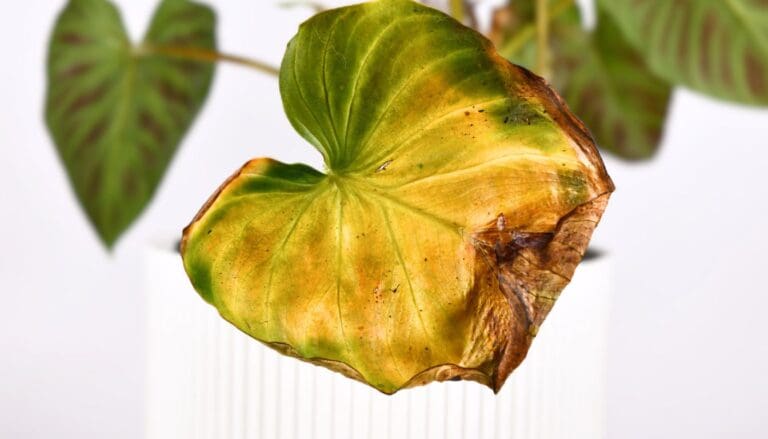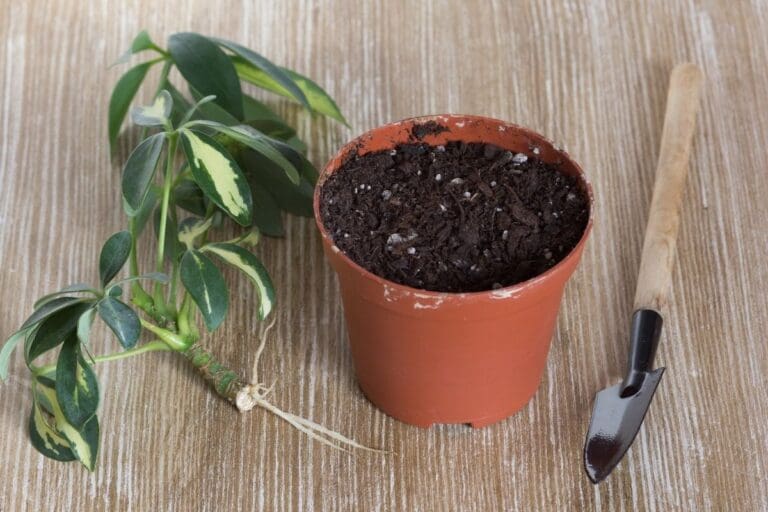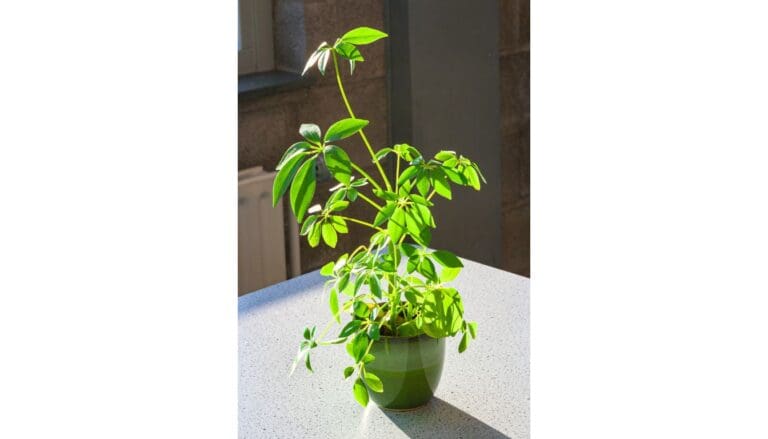Why Is My Calathea Turning Yellow? (Possible Problems+Solution)
Calatheas are popular indoor plants that are widely used for decorating homes and corporate rooms. They are sensitive plants, and if they don’t get adequate care, they might soon show signs such as yellow leaves.
But what do yellow leaves in calathea indicate? why is your calathea turning yellow? Let’s find out.
The primary cause of yellow leaves in calathea is incorrect watering. Apart from that, incorrect fertilization, low humidity, and pest infestations can also lead to the yellowing of leaves in calathea plants. To fix the problem, Examine the roots of the plant and correct the watering schedule.
It might take time for your Calatheas to recover completely, but it definitely will. This article will discuss the probable causes of yellow leaves in the Calathea plant and ways to fix them.

Please note: Simplify Plants is reader-supported. Some links in the post are affiliate links and I get a commission from purchases made through links in the post.
Why is my calathea plant leaves turning yellow?
Improper watering and inadequate use of fertilizers are the core reasons that lead to yellow leaves in Calatheas. But there are other reasons too. Let’s take a look.
- Inappropriate Watering
- Fluctuating atmospheric temperature levels
- Humidity levels
- Bright or low lighting
- Inadequate use of fertilizers
- Repotting
- Pest and fungal diseases
Now, we will briefly explain all of the reasons.
Inappropriate watering
Yellow leaves in Calathea are primarily due to inadequate watering.
Generally, Calathea prefers moist soil and atmosphere for growing with sufficient sunlight.
But both soggy and dry soil is a big no for a healthy plant. Thus if you overwater or underwater the plant, its health can deteriorate.
Overwatering can cause root rot, while under watering might affect your Calathea’s growth and lead to insufficient nutrition.
Calatheas might prefer weekly watering. Frequently watering the plant will cause root rot and yellowing of its leaves. And in winters, we recommend reducing the rate of watering even more.
When you underwater your Calathea, it will lose its moisture content. When the plant doesn’t get enough water or moisture, it loses its natural bright leaves and turns dull and pale yellow.
Using soil that can’t hold moisture, like sandy soil, leads to yellow leaves. These types of soils drain out the water through drainage holes and make the soil dry.
Hence, while choosing the soil for your calathea, be careful and understand your plant. The yellow leaves in calathea can also have other reasons, which we will discuss in the following points.
Also read: How Often To Water Calathea? (A Complete Calathea Watering Guide)
Fluctuating temperatures
Calathea is a native of the jungles of the Amazon, which is a humid place. Thus, cold temperatures are hard for them to tolerate. They prefer a temperature of 60-80°F.
Even if they are from a tropical part, their heat tolerance is up to 85°F. Too much heat tends to dry out the leaves of the plant.
Temperature above it or below it can deteriorate its health, and the first signs are yellowing and curling of leaves.
Low temperatures cause the reduction of chemical reactions that the plant performs.
Yellowing of leaves is caused due to decreasing levels of chlorophyll. A reduced level in chlorophyll will affect photosynthesis which will further affect the growth.
Choose a proper position for your plant where it doesn’t face temperatures below 50°F or above 90°F to reduce the yellowing and curling of leaves.
Also read: What Temperature Can Calathea Tolerate? (Ideal Temperature Range)
Humidity levels
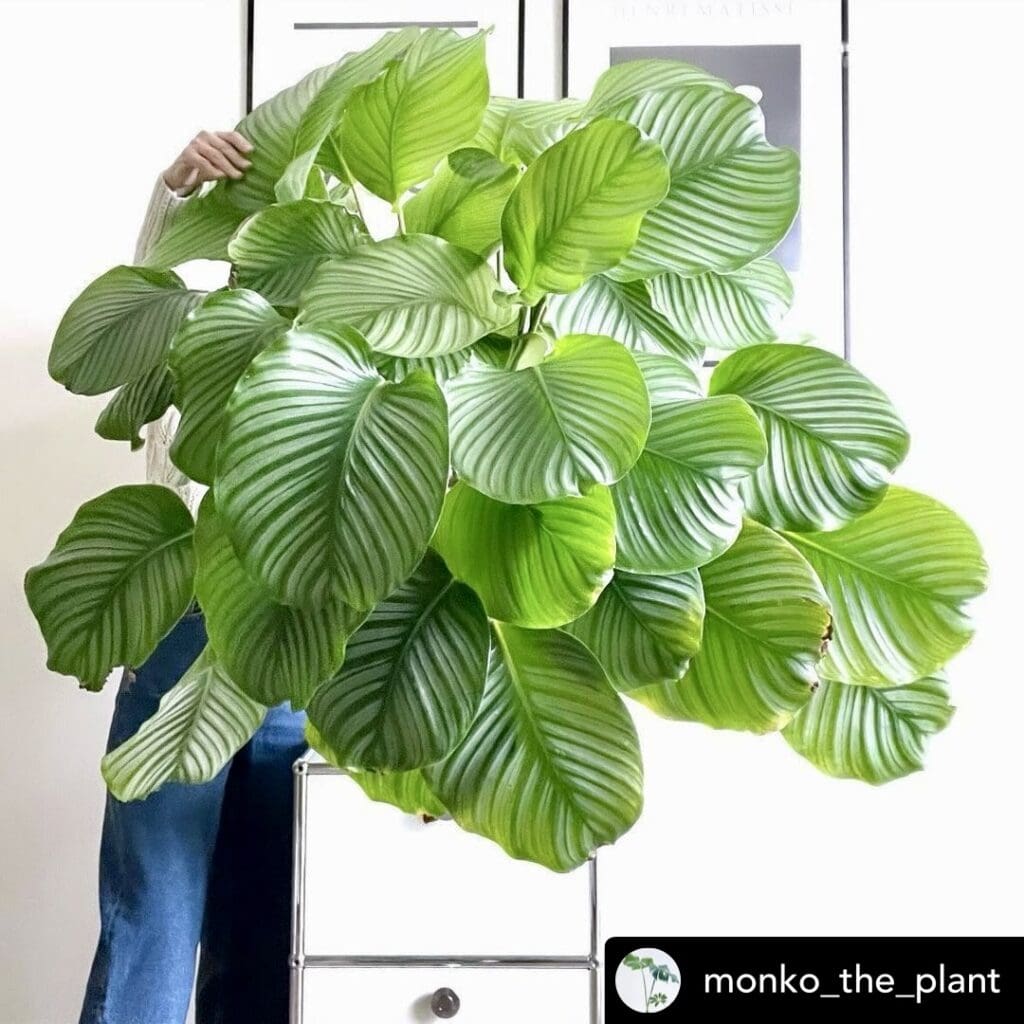
Being a tropical plant, Calatheas are skeptical about humidity levels. They need a humidity level of a minimum of 50%.
Low humidity is intolerant for them, as it dries out their leaves and makes them pale yellow and droopy. The humidity levels determine how much moisture the plant is gaining or losing due to transpiration.
If the humidity levels in the atmosphere of your plant fall, it will lead to dehydration. Dehydration can occur if there is no other way to gain back that moisture.
Check your plant if it is stressed. Some signs that your plant is receiving less humidity are yellowing of leaves, curling, crisp brown at the edges.
Also read: Should I Mist My Calathea Plant? (Calathea Humidity Requirements)
Bright or low lighting
Calatheas grow under the shade of large trees in the wild, so their natural lighting requirement is significantly less. They receive bright but not direct sunlight in their natural habitat.
Direct sunlight dehydrates the foliage of Calathea and further damages the cells. When they get more heat and direct sunlight than required, the leaves get dehydrated to compensate for water loss.
Low light or direct sun rays can lead to yellow leaves.
Also read: How Much Light Do Calathea Plants Need? (Calathea Plant Light Requirements)
Inadequate use of fertilizers
Fertilizers supply nutrients to the plants. Calatheas are one of those plants which don’t need heavy fertilizers for growing.
Overfertilizing can lead to yellow leaves as it supplies more nutrition. Underfertilizing can also cause pale yellow leaves due to less nutrition, but that’s in rare cases.
Overfertilization can make the plant weak and prone to pests and other diseases, leading to an unhealthy plant.
Signs of over-fertilization are stunted growth, salt accumulation in the layer of the soil, wilting, yellowing of leaves, and sometimes a dry Calathea plant.
All houseplants need nitrogen, phosphorus, calcium, magnesium, and potassium fertilizers, but overusing these components might harm.
Let’s thoroughly discuss the benefits and role of these nutrients.
Nitrogen: It helps in the formation of more leaves, builds protein.
Phosphorus: It induces metabolic growth, helping in the growth of roots and stems. Thus, helping the overall growth of the plant. Phosphorus also increases the strength of the roots.
Potassium: Potassium helps in giving shiny leaves to the plants and pushes the growth of flowers.
Also read: Should I Fertilize Calathea? (How Often+Best Fertilizer)
Repotting
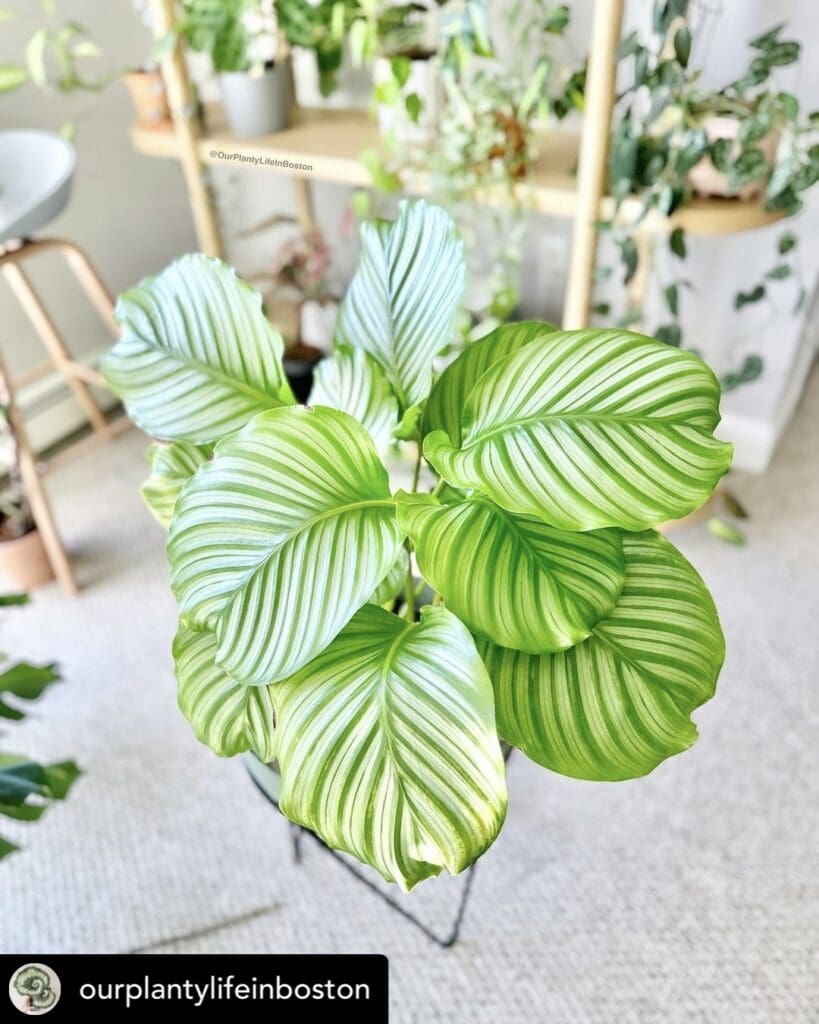
Calathea needs repotting every 12-18 months or when they are root-bound or undergoing root rot. Choosing the right pot and soil is a must for repotting.
But repotting a whole houseplant is not everyone’s cup of tea. Plants need a week or more to adapt to their new surroundings after being transferred to a new pot.
Yellowing leaves are not a big issue in this case. The roots just need a little more time to get accustomed to the new soil.
Also read: Do Calathea Like To Be Root Bound? (+When To Repot)
Pests
Pests prefer humid places that will provide them with moisture.
Pests like spider mites, aphids, mealybugs, scale insects, fungus gnats root, knot nematodes, and caterpillar slugs are very common to Calathea, and among them, spider mites are famous.
Spider mites hate brightness and humidity, but they can still attack Calathea even on hot and humid days.
Pests are not that easy to spot, but when you see yellow leaves on your Calathea, check the lower parts of the leaves properly. Pests generally hide from sun rays and water, so they start residing there.
Pests are a pain to get rid of, and one can use organic methods or pesticides to remove them.
Fungal diseases
Fungal diseases can be typical if the humidity is high. Humid weather conditions and moisture are ideal for fungal growths.
Your plant may look healthy from the outside but still have some yellow leaves on it; then, there must be something.
If fungal infections aren’t treated properly, they can lead to severe diseases, including yellow, pale leaves and stems.
How do you fix yellow leaves on calathea?
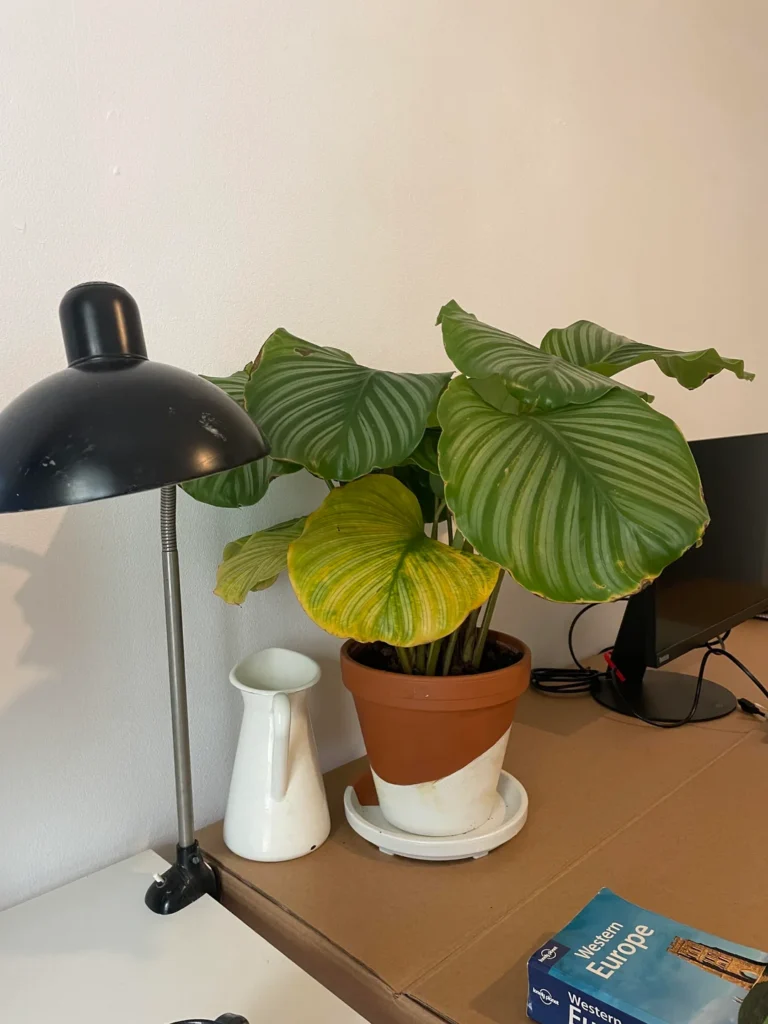
In the above sections, we have discussed the causes of yellow leaves on Calathea. Now, we are going to tell you some quick remedies.
Proper watering
Giving sufficient water to your plants is essential. The core cause of yellow leaves in Calathea is inappropriate watering that is overwatering and underwatering.
Remember that your Calathea needs weekly watering. It loves moist soil that is not soggy.
Check the soil before watering the plant. Use your fingers to dig the soil and check if it’s dry or needs some water. This will prevent overwatering.
Drain the excess water from the soil through the drainage hole.
To control underwatering, just water your plants weekly.
Say you have watered your plant on Monday, then water it again following Monday or Sunday.
Do examine it properly every day to avoid dry soil.
Controlling Humidity

Calatheas need 50-60% moisture in the atmosphere to grow well. Low moisture can make the leaves dry and yellow.
You can use water spray to maintain the moisture. You can do it at regular intervals just to raise the humidity level.
Place the pot away from the air conditioner as it can dry its natural moisture content.
Nowadays, Room Humidifiers are used to maintain humidity levels. Humidifiers are an excellent way to maintain the humidity level for all your house plants.
Don’t hesitate to relocate your Calathea to your bathroom or kitchen for humidity.
Put some pebbles in the tray, add some water until the pebbles are half-drowned, and put the pot on the pebbles. The pebbles will avoid direct contact with the roots with the water.
When the water in the tray evaporates, it will increase the moisture in the atmosphere.
Repotting
After repotting, a calathea might take some time to adjust. This is because you have stressed your plant by putting it in a new environment.
Ensure that the new pot is bigger than the previous one. It has drainage holes to drain out excess water, and the temperature is also controlled.
Calatheas need care and pampering to fix them.
Don’t fertilize the plant for a month after repotting. Let it grow naturally and take all the nutrients from the soil on its own.
Maintain the lighting
Place the Calathea in a new spot where it will receive proper light.
The early morning sun rays are perfect for Calatheas, soothing, comfortable sunlight with light winds.
Keep the pot in a spot that doesn’t receive direct sun rays.
In low light situations, keep the plant where it can get its required lighting. If you can’t get a suitable spot, buy those artificial lights. Artificial lights are readily available in Nurseries and shops where they sell plants.
Artificial lights are easy to use. You can also maintain the light intensity according to requirements.
Pests

We have learned that pests can cause yellow leaves, so we have some organic solutions for you.
Neem oil: Neem oil is an excellent natural insecticide that also removes fungus.
Mix 2 teaspoons of neem oil to a gallon of water in a spray bottle and spray it all over the calathea. This spray can neutralize pests.
Alcohol spray: Add 2 cups of isopropyl alcohol in a quarter of water, then spray it on the infected parts of your Calathea plant. It will clear the plant and remove bugs.
Herbal water spray: Herb-infused essential oils can also help with pests. Rosemary, sage, mint, thyme, and Basil infused essential oils are very effective.
You can make your oil by adding fresh herbs to the oil and soaking overnight. Then dilute it in water.
You can also buy herbal oil from a shop and dilute it to use. Fill the mixture in a spray bottle and spray all over the Calathea.
Garlic: Peel some cloves of garlic and stick them in the soil. The pungent smell of garlic helps to get rid of bugs.
Soapy water: Add a few tablespoons of mild soap or shampoo to equal cups of water and spray it on the plant. It will repel bugs from the plants and leaves to a great extent.
Be careful because too much soap can cause harm.
Using proper fertilizers
Over-fertilizing can not only make the leaves of the Calathea plant yellow but also kill it.
You should always use well-balanced fertilizers with a 10:10:10 ratio of N:P:K (Nitrogen: Phosphorus: Potassium). Always fertilize your plant in the active season with the mentioned balanced ratio.
How do you keep Calatheas from turning yellow?
Here are some tips to prevent yellow leaves on your Calathea.
- Always maintain a proper balance between light and shade.
- Keep the Calathea in a place where it will receive bright light but not direct sunlight. The place should also not be too shady.
- Trim the yellow leaves and damaged stems to make the plant focus on the growth of new leaves.
- Examine the soil of your plant before watering it. Calatheas generally need weekly watering but keep examining the soil regularly to avoid over or underwatering.
- Tap waters can have a high content of chlorine, iron, and other minerals, which might be harmful to your plant. So consider using filtered water.
- Keep the calathea in a humid atmosphere. If needed, install a room humidifier. It will control the humidity level in the room, providing a comfortable atmosphere.
Recommended Garden Supplies
| Product Image | Our Recommended Gardening Supplies | Check Offers! |
|---|---|---|
Top Top
Top
Top
Top
Top
Top
Top
Top | rePotme Houseplant and Tropical Classic Potting Soil Mix | Check Offer On Amazon |
 Top
Top
Top
Top
Top
Top
Top
Top | Espoma Organic Indoor Plant Food | Check Offer On Amazon |
 Top
Top
Top
Top
Top
Top
Top
Top | GooingTop LED Grow Light 6000K Full Spectrum Clip Plant Growing Lamp | Check Offer On Amazon |
 Top
Top
Top
Top
Top
Top
Top
Top | Soil Moisture Meter | Check Offer On Amazon |
 Top
Top
Top
Top
Top
Top
Top
Top | Govee Hygrometer Thermometer, Bluetooth Enabled! | Check Offer On Amazon |
 Top
Top | LEVOIT Humidifiers for Large Room(Best For Plants) | Check Offer On Amazon |
 Top
Top
Top
Top
Top
Top
Top
Top | Upgraded DIY Automatic Drip Irrigation Kit, 15 Potted Houseplants Support | Check Offer On Amazon |
 Top
Top
Top
Top
Top
Top
Top
Top | Stainless Steel Heavy Duty Gardening Tool Set | Check Offer On Amazon |
 Top
Top
Top
Top
Top
Top
Top
Top | Bonide Insecticidal Soap | Check Offer On Amazon |
 Top
Top
Top
Top
Top
Top
Top
Top | Bonide 32 oz Spray Neem Oil for Organic Gardening | Check Offer On Amazon |
 Top
Top
Top
Top
Top
Top
Top
Top | Garden Safe Fungicide | Check Offer On Amazon |

